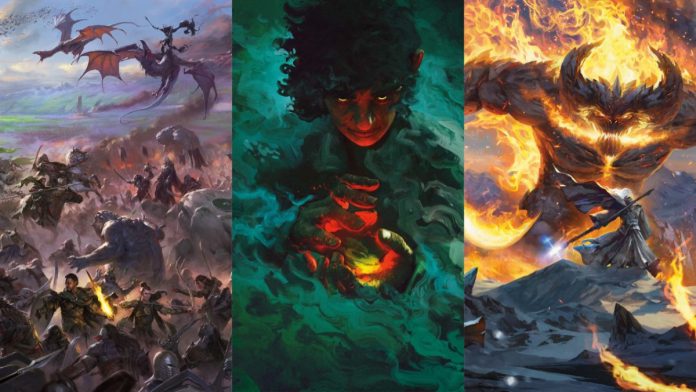The upcoming Magic: The Gathering set The Lord of the Rings: Tales of Middle-Earth is all based around the foundational fantasy texts. But that does mean the texts – Wizards of the Coast are basing these cards on the books not on the Peter Jackson movies. That means that many things omitted in the films can be referenced and brought to the fore, and there are some interesting differences on show in the art and mechanics that illustrate the original vision of the book. We’re diving in today with Lupe (as our resident Tolkien dork) and FromTheShire (for insight into Magic and what the cards do) as they choose a few cards each to talk about and consider from a rules and lore perspective.
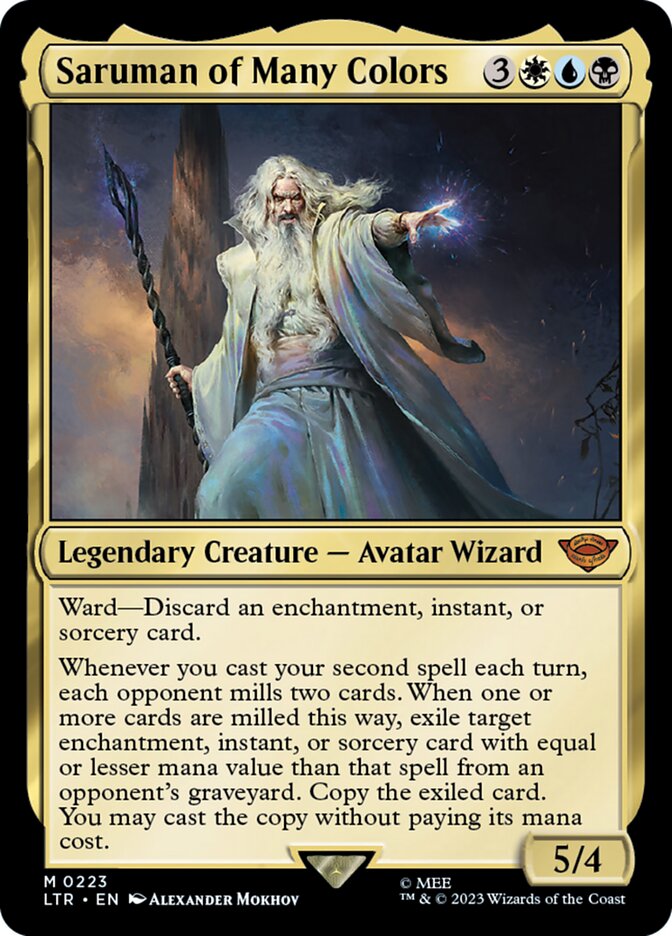
Saruman of Many Colors
Lupe: This was my first pick from the previewed cards, because I think it’s a really interesting element of Saruman that doesn’t get seen in the movies at all but is integral in the book. Gandalf returns as Gandalf the White (uh, sorry, spoilers) but he does that because there is no White Wizard anymore. In the movies Saruman is still treated as Saruman the White throughout, but in the books it’s handled very differently, as we see from this passage related by Gandalf:
‘For I am Saruman the Wise, Saruman Ring-maker, Saruman of Many Colours!’
I looked then and saw that his robes, which had seemed white, were not so, but were woven of all colours, and if he moved they shimmered and changed hue so that the eye was bewildered.
I liked white better,’ I said.
White!’ he sneered. ‘It serves as a beginning. White cloth may be dyed. The white page can be overwritten; and the white light can be broken.’
In which case it is no longer white,’ said I. ‘And he that breaks a thing to find out what it is has left the path of wisdom.’
It is Saruman who abandons his status as the White Wizard, and instead embraces a path that is brighter, more enchanting, but lacking in wisdom. Gandalf is the closest thing we have in the book to an authorial voice (if he says it is so, we the reader can effectively be sure that it is such), and so this is a damning part of the narrative. This is the moment not just where Saruman reveals his betrayal, but his fall from wisdom.
FromTheShire: It’s pretty cool that this is such an impactful passage, but I wish that was maybe reflected a little better in the mechanics of the card. In an abstract way cards are supposed to represent your knowledge in Magic, and the way Saruman works is then much more about him forcing you to give up some of your knowledge to destroy him, and him taking knowledge from others. Maybe it’s delving more in to his thirst for knowledge and wisdom and being slowly entrapped by his use of the Palantir? That kind of makes sense, that it’s less about his abilities once he is of many colors and more about the journey that ends there.
In game terms, it’s free value, what’s not to love? You have to cast two spells to trigger it which will sometimes be an issue but is something you’re striving to do anyway. It also gives you a little bit of graveyard hate which is always nice. Do note that the spell you exile doesn’t have to be among the ones that are milled by this trigger, meaning having additional mill in the deck can pay off.
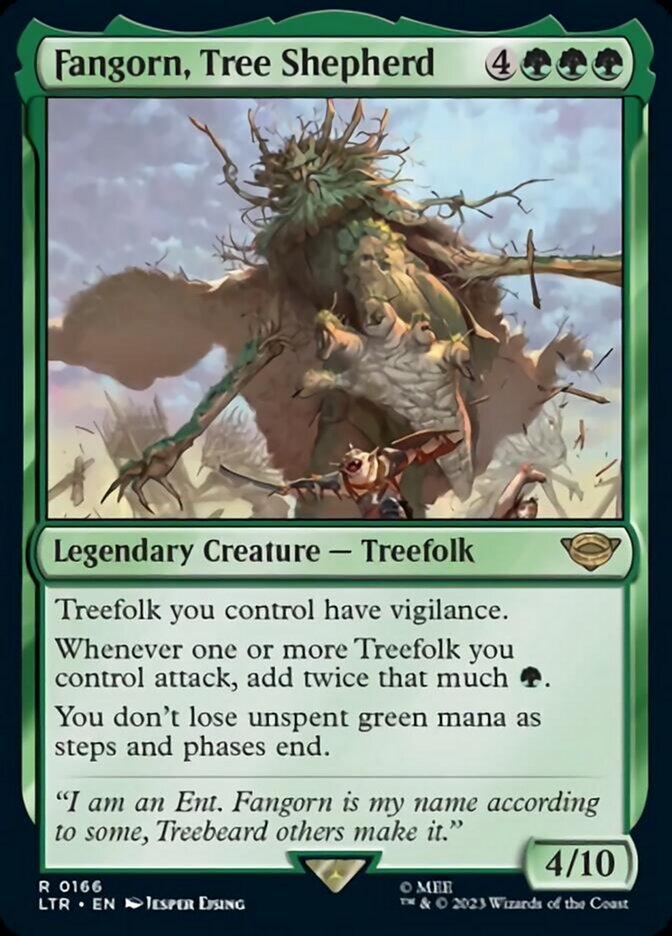
Fangorn, Tree-Shepherd
Lupe: Though we can’t see all of Fangorn, also known as Treebeard, here it’s enough to see that the artist has struck a balance between the book description and the common appearance known from the movies. The depiction of Ents, which is an Old-English word simply for “giant”, as walking trees rather than humanoid creatures with some tree-like features, is something that goes back far further than Jackson’s interpretation – lots of illustrations and depictions choose to depict them like this. But the book describes them quite differently:
They found that they were looking at a most extraordinary face. It belonged to a large Man-like, almost Troll-like, figure, at least fourteen foot high, very sturdy, with a tall head, and hardly any neck. Whether it was clad in stuff like green and grey bark, or whether that was its hide, was difficult to say. At any rate the arms, at a short distance from the trunk, were not wrinkled, but covered with a brown smooth skin. The large feet had seven toes each. The lower part of the long face was covered with a sweeping grey beard, bushy, almost twiggy at the roots, thin and mossy at the ends. But at the moment the hobbits noted little but the eyes. These deep eyes were now surveying them, slow and solemn, but very penetrating. They were brown, shot with a green light.
I’m glad to see that we have toed feet here (though with five rather than the seven toes he’s later described as having) and generally Fangorn is depicted in this picture rather more like a treeish person than a personish tree, and that’s great. That said, we can see the arms are rather more branch-like than we’d expect, and there are other nods to suggest he’s a good part tree himself. It’s an interesting attempt to hit a midpoint between the familiar and the authentic, and I appreciate that.
FromTheShire: Fangorn is one of the greenest creatures that ever did green. Big casting cost, big toughness, big mana production. He fits in a narrow range of decks but boy is he tailor made for them. Most commonly he’ll slot into Doran, the Siege Tower decks where he’ll effectively be a 10/10 for 7 mana which is great. Giving vigilance to your team is fantastic, especially in Commander, since you are on defense for 3 other players’ combat steps rather than just 1. This means you can still crash in with your huge creatures while being able to block, and more likely than not pushing attacks completely away from you.
Because your spells are likely to be on the expensive side, his second and third abilities are clutch as well, producing a bunch of extra mana and then also stashing it for future turns so you can cast multiple spells per turn which is a huge benefit in snowballing out of control to victory.
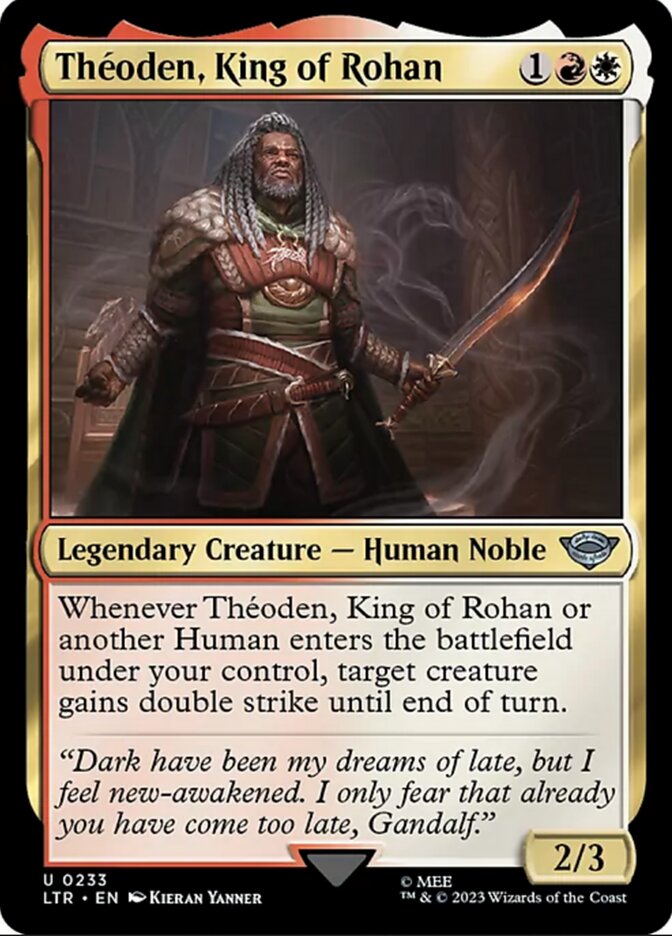
Théoden, King of Rohan
Lupe: One of the things that Tolkien expressly wanted when he wrote his legendarium (as the body of his work set in Middle Earth is known), was to create a “myth for England” in the same way that other cultures had their own heroic myths and legends. Tolkien was, of course, thoroughly aware of the various early English peoples that inhabited the island (it was a subject of his academic expertise), but he felt that it didn’t reflect the blended, multifaceted aspects of this scepter’d isle. As such he created something that, in his mind, would stand alongside the mythological canons of other peoples. Perhaps Tolkien didn’t fully realise what he was creating by mimicking these works, for I would argue in many ways he succeeded – his works spawn thousands of imitators, reimaginings, reworkings, and retellings, which is exactly what a legendarium does for its culture.
Modern England is not the same place that Tolkien lived in, and the cultural underpinnings of his work have a far wider reach than just my homeland. So having these touchstone myths, these legends be told and retold for modern audiences is only natural. There’s little doubt that Tolkien envisioned the Roharrim as white – it would be silly to argue otherwise given the textual evidence we have. But that’s not how myths work, they don’t stay static. And it is the truest possible devotion to the goal of Tolkien’s works to reinterpret them and retell them in new ways. This Théoden, proud and aged but strong and fearsome, is a retelling of that mythic image, updated for peoples who have a connection to it but aren’t directly represented. This syncretism is one of the most natural parts of all human society, and to see the legendarium given this treatment fills me with joy. The armour here is not what the king is described as wearing, it has few of the details mentioned. The man’s features are not the same as in the book. And yet it has a power, a motion, a stance and a solidity that reflects the inner truths of the character of the King of Rohan. And so this, too, is Théoden, King of Rohan.
FromTheShire: Boros decks (red and white) are renowned for doing one thing and one thing only: attacking. While we have gotten some notable exceptions in recent years, at their core the color pairing has not changed, and it’s still an effective strategy when deployed correctly. One of the biggest boons to this ‘aggro’ play style is ending the game quickly before slower, more controlling decks can get their defenses fully set up, and what better way to do so than literally hitting twice per combat with double strike? This is frequently paired with lots of Equipment such as Sword of Forge and Frontier as well to double up those juicy triggers.
Being limited to only triggering off of Humans entering play is somewhat limiting, but there are a ton of useful Humans that will slot right in, and I think you’ll find it’s not actually much of a struggle to at least get your key creatures double strike regularly.
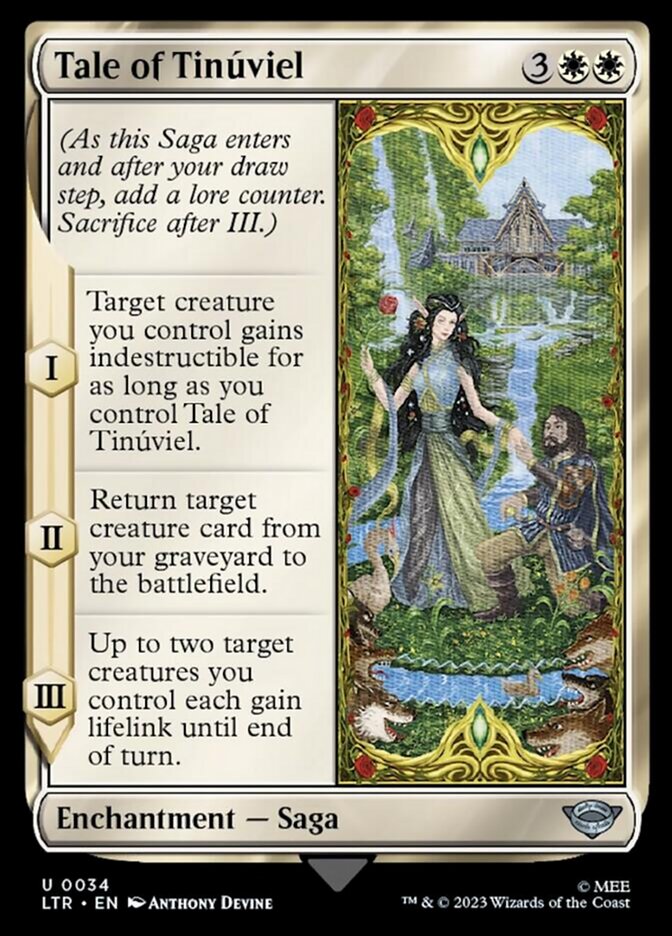
Tale of Tinúviel
Lupe: The Tale of Tinúviel is one of the very first things that Tolkien wrote in his legendarium, and was a story he returned to repeatedly to retell. It contains much which would be unrecognisable in the later versions, including mentions of gnomes! But the story contains the first version of the story of Beren and Lúthien (in this story known as Tinúviel), which would remain into the later works. In rough strokes Beren (in this version a gnome, but later a human) seeks the hand of Tinúviel and her father offers it if he can retrieve one of the Silmarils from the crown of Morgoth (Morgo in this version). Their bond, the risk of death, the sacrifice of immortality and the link that forms between their lives is epic in scope and this card does an admirable attempt to encapsulate it. The art style also puts me in mind of a tapestry, that emphasises the historical sense of the tale.
The story of Beren’s attempts to retrieve a Silmaril, and the love of Beren and Tinúviel is a long and tangled one, but also one at the heart of Tolkien’s works. For their granddaughter Elwing would eventually marry Eärendil and they would have a son, half-elven like the rest of their line: Elrond. It also ties heavily into, unsurprisingly, The Silmarillion, Tolkien’s book of tales and myths of the first ages of Middle Earth which serve as the background grounding The Lord of the Rings.
FromTheShire: Sagas are a relatively recent addition to Magic, and they are perfect for exactly these situations. It’s not telling the current story but rather laying out an old tale that has impacted the current one. They even have a feeling of story beats as they tick up turn after turn, stepping through the stages of the legend.
In this case, the indestructibility isn’t bad but 5 mana is a lot to pay to rent it for a few turns. Depending on if you say have a way to get expensive creatures into the graveyard the ability to return one directly to the battlefield can be powerful, and it’s not an effect you get terribly commonly in white which does merit some consideration. Finally, getting lifelink for a turn can pull you back into a Limited game in a big way, which I think is where this has a home.
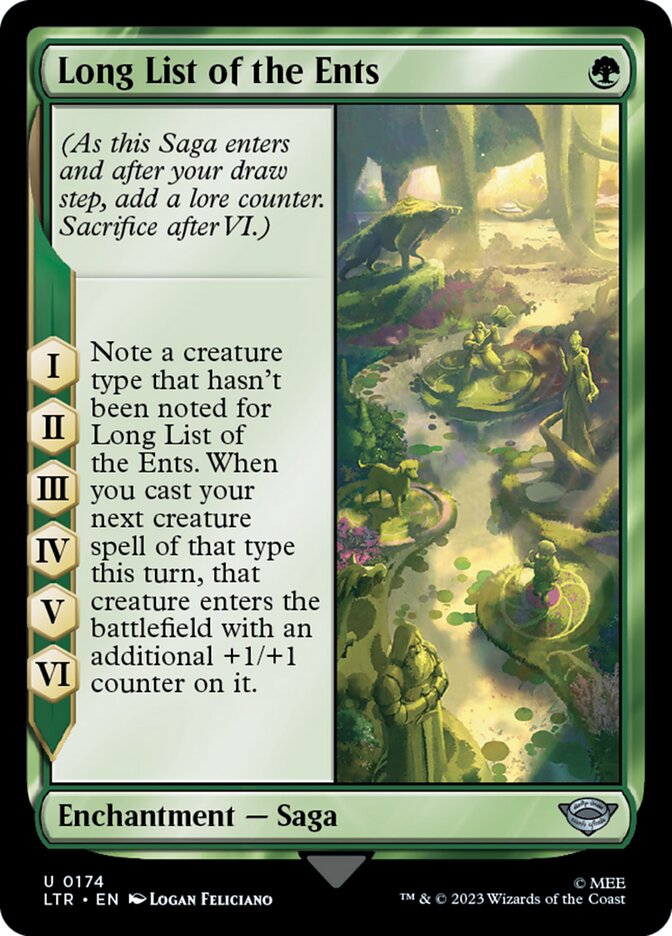
Long List of Ents
Lupe: I adore this card. The Long List of Ents is a poem that the Ents know that details the creatures that live in Middle-Earth. You want to know why Treebeard’s confused about the hobbits and thinks they’re orcs? It’s because they’re not in the long list. He tells Merry and Pippin some of the list in poetic form:
Learn now the lore of Living Creatures!
First name the four, the free peoples:
Eldest of all, the elf-children;
Dwarf the delver, dark are his houses;
Ent the earthborn, old as mountains;
Man the mortal, master of horses:
Beaver the builder, buck the leaper,
Bear bee-hunter, boar the fighter;
Hound is hungry, hare is fearful…
Eagle in eyrie, ox in pasture,
Hart horn-crownéd; hawk is swiftest,
Swan the whitest, serpent coldest…
It’s clear the list continues, but Treebeard expects beings like Hobbits to be up at the top with the free peoples, and the fact that they’re not confuses him. This is such a fun, innocuous thing to hook a card into, and the fact that it lets you name creature types just makes me appreciate it all the more.
FromTheShire: Extremely flavorful card that may have a home in a Standard deck or maaaaybe in a Volo, Guide to Monsters deck. There are certainly times where it’s good to put counters on creatures, especially that first counter, but you really need something in the deck that rewards you for playing a bunch of different creature types more than a single counter. Most of the time you are trying to build your deck with as many synergies as possible, and more often than not those are found within a particular tribe, the exact opposite of what this card wants.
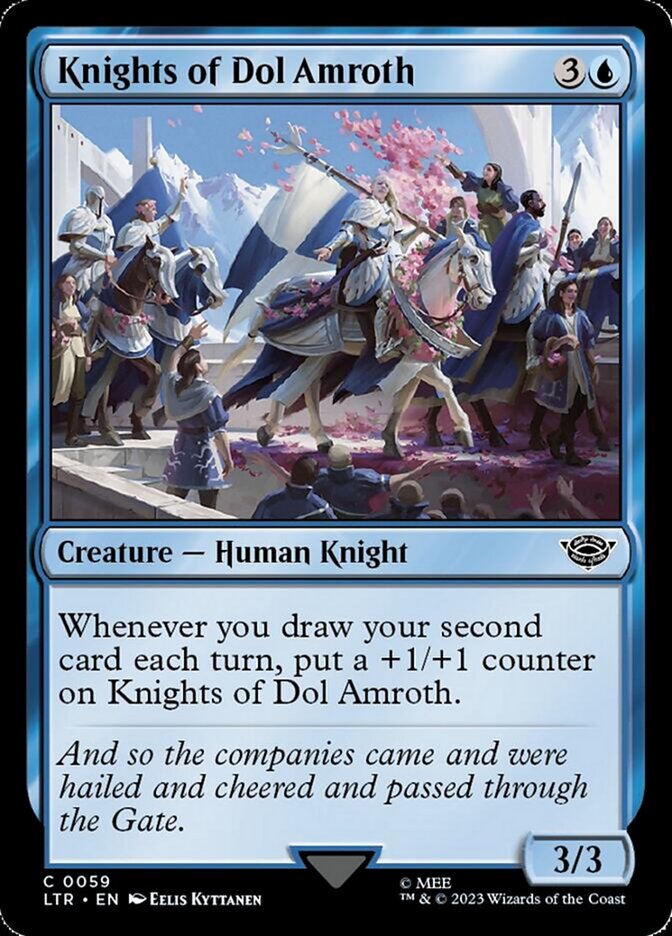
Knights of Dol Amroth
Lupe: Probably the most important fighting force at the Battle of Pelennor Fields not featuring in the movies (just behind the fiefdom troops that in the book Aragorn brings north on the boats), the Knights of Dol Amroth are interesting for a number of reasons but particularly their equipment and manner of war. The scale (?) armour they’re depicted here isn’t authentic to the book, but the brightness, sense of heavy armour and the heraldry is close (the only thing missing are copious swan motifs).
Of all fighting forces in the entirety of The Lord of the Rings, the Knights are described by Tolkien as wearing “harness”. As a medievalist, he absolutely knew what this meant (plate armour) and he uses it to contrast the armour worn by others (ubiquitously chainmail). So these knights are intended to be wearing probably partial plate over chainmail, which would have made them the military equivalent of a small column of main battle tanks arriving at Minas Tirith. During the Great Peasants’ Revolt in real world history a single minor noble joining the peasants was enough to cause ripples of alarm throughout northern Europe, because a small complement of armoured knights were with him. It’s hard to overstate the impact of such troops in play. And in the book this plays out. Prince Imrahil, their leader, is one of the fiercest combatants, and rallies with Aragorn to launch a counter-attack.
As such, I might have liked to have seen this card be a little scarier. That said, the buff when additional cards are drawn is a narrative counterpart to their role in Aragorn’s arrival, which is neat storytelling.
FromTheShire: I don’t remember these guys well since it’s been quite a while since I read the books, but yeah, they certainly are not as scary in the game as they are in them. 4 mana to cast a 3/3 is not a good rate, even with the theoretical ability to grow larger. The one place I could see this possibly being played is Sidar Jabari of Zhalfir decks, where you know you will be consistently drawing 2 cards on your turn to pump them up, and you may even be able to cheat them in to play so you don’t feel so bad about overpaying to cast them. At the end of the day, not everything can be a rare or mythic rare, some things have to be commons.
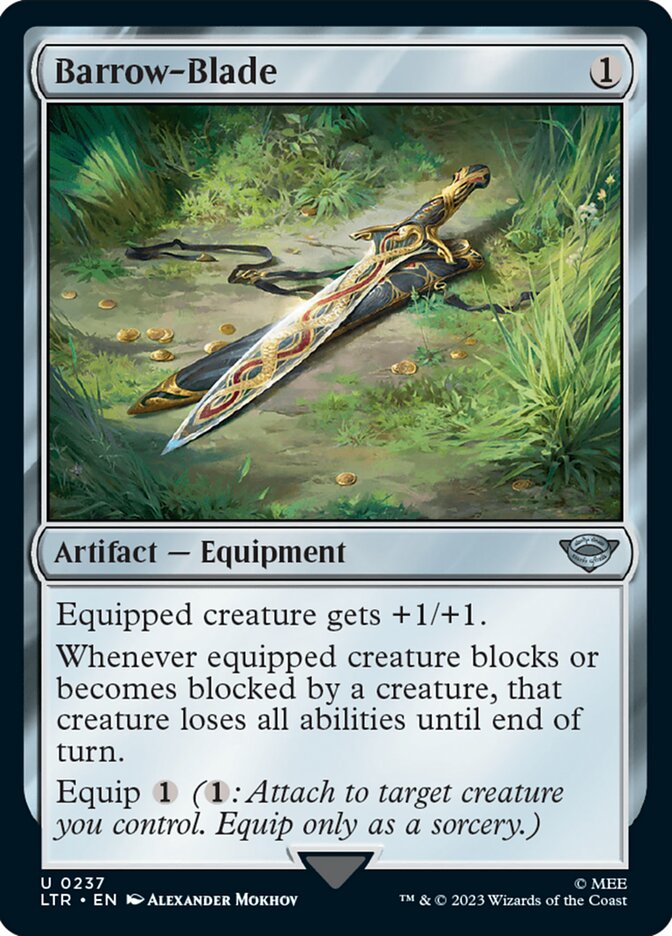
Barrow-Blade
Lupe: One of the largest sections of the books that was simply cut from the movies are the travels of the four hobbits before they meet Strider at The Prancing Pony. This has many parts that are omitted, including an encounter with elves travelling on the road, but the largest section is when they venture into Old Forest and encounter Tom Bombadil, a merry old fellow who promises to help them if they are in need and sing to call him. After they leave his house they venture out onto the Barrow Downs and there end up lured into one of the Barrows and preyed upon by one of the Wights that dwell there. They are rescued by Tom, and from the Barrow he retrieves four daggers that the hobbits use as short swords – the Barrow-Blades.
These blades play a role in the unfolding adventures in many small ways, but the biggest is at the Battle of Pelennor Fields. There Merry stabs the Witch-King of Angmar in his knee with one, wounding him badly, and allowing a distraction for Eowyn to strike a killing blow. But why does this knife work when other weapons do not?
As Tom Bombadil tells the hobbits, at least in part, the daggers were forged by the people of Arthedain in their war against Angmar. They weren’t just any old daggers found in a burial mound – they were enchanted in their crafting to do harm to Angmar and its ruler, the Witch-King. And thus, over the centuries since their downfall, those ancient people manage to provide the weapon that allows for the Witch-King to be slain.
FromTheShire: In a way it’s appropriate that this is probably directly after Tom pulled them out of the barrow and before their true power became known, because this is mostly just okay. Fortunately it is cheap to cast and equip, and you’re never going to turn down +1/+1. The trigger to remove all abilities is an interesting one since it doesn’t do anything to actually shrink the creature or make your creature more likely to survive the combat, and a lot of the time there simply isn’t going to be a meaningful ability to remove. That said, if you are actually playing it, it kind of does the thing it’s supposed to – remove indestructibility and make something horrendous killable. It’s not so much that removing the abilities from a Blightsteel Colossus is useless, it’s more that it’s a very narrow use case that other, more generally useful cards solve equally well, or even better.
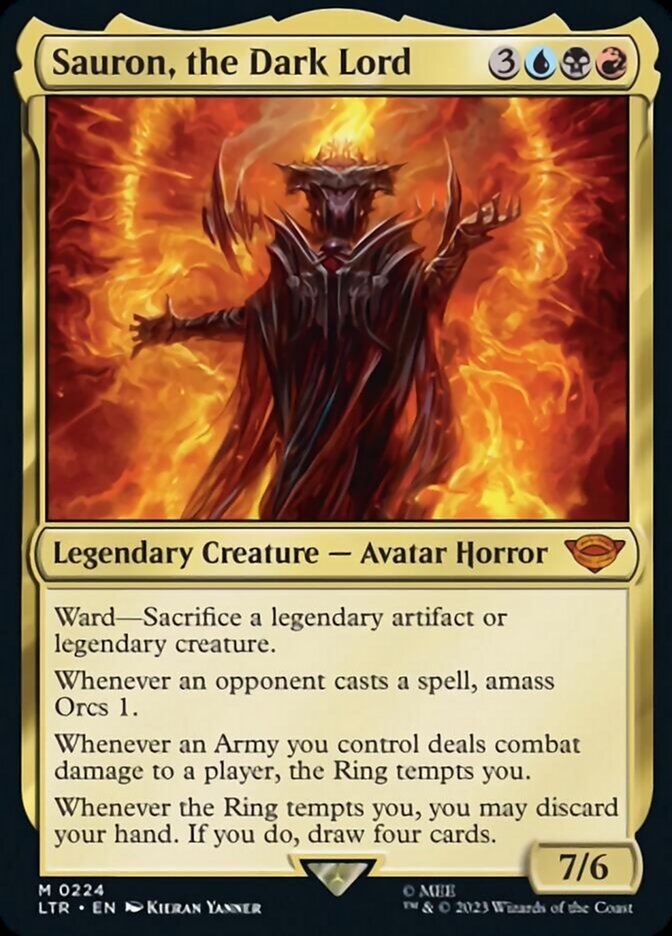
Sauron, the Dark Lord
FromTheShire: When it came time to pick the cards I wanted to write about, I knew immediately that I had to talk about Sauron, the big bad himself. Not only are the bad guys always cool, he’s in Grixis (blue, black, and red) which is probably my favorite color combination, and I love his abilities. First he has a ward to protect himself that is both painful enough for your opponent to pay that it offers a genuinely good chance to stick around for a while, as well as being thematically perfect. You’re going to have to cough up that ring if you want to defeat us, Mr. Frodo.
So what does that protection buy us time to do? For starters, whenever any opponent casts a spell we amass Orcs, meaning we create an Orc Army token if we don’t already have one or add a +1/+1 counter to grow our army if we do. This can easily add 3-6 power for each wheel of the table, which adds up quickly. Next, we can send our horde out in search of the ring, and if we damage a player it tempts us, offering an array of bonuses. In addition, unlike the average mortal who merely draws a little of the ring’s power, we can unlock its full potential and use it to dominate Middle-earth and the game by discarding our hopefully empty hand and drawing 4 new cards each time it tempts us.
Lupe: The thing that jumps out at me from this card, more than anything else, is that Sauron, the Dark Lord, here is classified as an avatar horror. That plus the artwork is a fascinating depiction of him that aligns only incompletely with the book. Sauron was originally Mairon, one of the Maiar – spirits that helped the Valar (the Powers of Arda who shaped and rule the world) create Ëa “on the ground” as it were. “Avatar” feels strange, because Sauron is not a projection of a greater being in the form depicted, but an physical manifestation of a usually spiritual one. “Horror” also seems odd, because while he is foul and dark, his nature is not essentially different to any other Maia (such as Gandalf) and it feels odd to distinguish him when his betrayal and fall from grace is a such a key part of his character. The depiction of him in the art is honestly a fair interpretation of his physical form – we have little direct description in the text for him, noting only that he was larger than a normal person and “an image of malice and hatred made visible”. That combined with the fact he’s described as having burning hands leads to the fiery depiction, but in truth he was more associated with shadows and darkness.
I do very much like the mechanics though. The drawing of Orcs to him is a key facet of his power, and his inheritance from Morgoth, the previous dark lord. Where Sauron poured his power into the rings, hoping to win dominion over the free peoples with them, Morgoth invested his power into twisted and corrupted beings of his own creation, Orcs foremost among them. The power over the Orcs is one of the significant markers of Sauron as Dark Lord in his own right. Sending them out to find the Ring is also fun, and I really like that aspect of the mechanics matching the text.
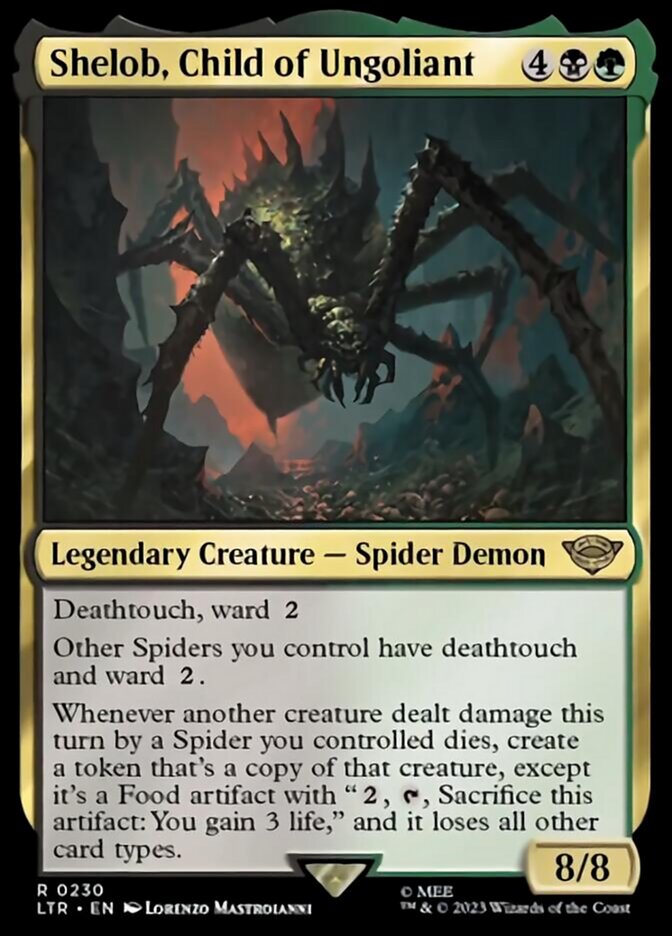
Shelob, Child of Ungoliant
FromTheShire: This may be my actual favorite card in the set. I’m a huge fan of tribal creature decks, and while we have had Ishkanah, Grafwidow as a legendary creature to helm our Golgari (black and green) Spider decks, it didn’t really fit perfectly since it doesn’t actually benefit your other spiders, it mostly offers you an expensive payoff if you managed to already be doing well. Shelob however is fantastic. Once again we have a ward ability which is significantly weaker than Sauron’s as well as deathtouch which is largely overkill on such a big creature but crucially they hand both of those abilities out to the other spiders you control which matters much more.
Across the board, spiders tend to be fairly low power and toughness which means they can have difficulty getting in to combat profitably, so giving them all deathtouch (any amount of damage it deals to another creature will destroy it) is a huge boost and turns Arachnogenesis into a one sided board wipe. Now either your spiders will be getting through unblocked to kill your opponent, or they will be trading favorably with your opponents creatures with both dying. When THAT happens, Shelob’s finally ability comes in to play, creating a non-creature token copy of their creature as a Food, which again is thematically brilliant. This token also retains any activated, triggered, or enters the battlefield abilities the original had which is extremely strong. All of this on an aggressively costed creature? Sign me up.
Lupe: This is an interesting interpretation of Shelob. Though she is described as spider-like, she’s explicitly not a spider in the text – Tolkien describes her also as having features akin to a scorpion or a crustacean. The visual depiction on the card is compelling, but has little in common with the text – Shelob is noted to be horned, have two clusters of eyes, a claw at the end of each of her legs, a beak that dribbled venom, hair like steel wire over those legs, and her black hide is blotched with “livid marks” and her belly is “luminous” white. So the fact that they’ve chosen to interpret her strictly as a spider (and tie her strongly into the spider creature type) is a little disappointing, truth be told.
It’s also odd to me that while they’ve modelled her poisonous sting with Deathtouch, but not included anything that jumps out as an obvious mechanical representation of her most distinct feature: her natural weaving of shadows and darkness:
In a few steps they were in utter and impenetrable dark. Not since the lightless passages of Moria had Frodo or Sam known such darkness, and if possible here it was deeper and denser. There, there were airs moving, and echoes, and a sense of space. Here the air was still, stagnant, heavy and sound fell dead. They walked as if it were in a black vapour wrought of veritable darkness itself that, as it was breathed, brought blindness not only to the eyes but the mind, so that even the memory of colours and of forms and of any light faded out of thought. Night always had been, and always would be, and night was all.
And later the effect becomes even more pronounced:
But after a time their senses became duller, both touch and hearing seems to grow numb, and they kept on, groping, walking, on and on, mainly by the force of the will with which they had entered, will to go through and desire to come at least to the high gate beyond.
It would have been great to see some reflection of this in the card. Ungoliant, Shelob’s mother, was not “a giant spider” but instead a primordial being from either the creation of the world or predating it and whose power was to weave shadow and darkness and horror together, and to consume. “Demon” feels a strange choice, when “Horror” is right there.
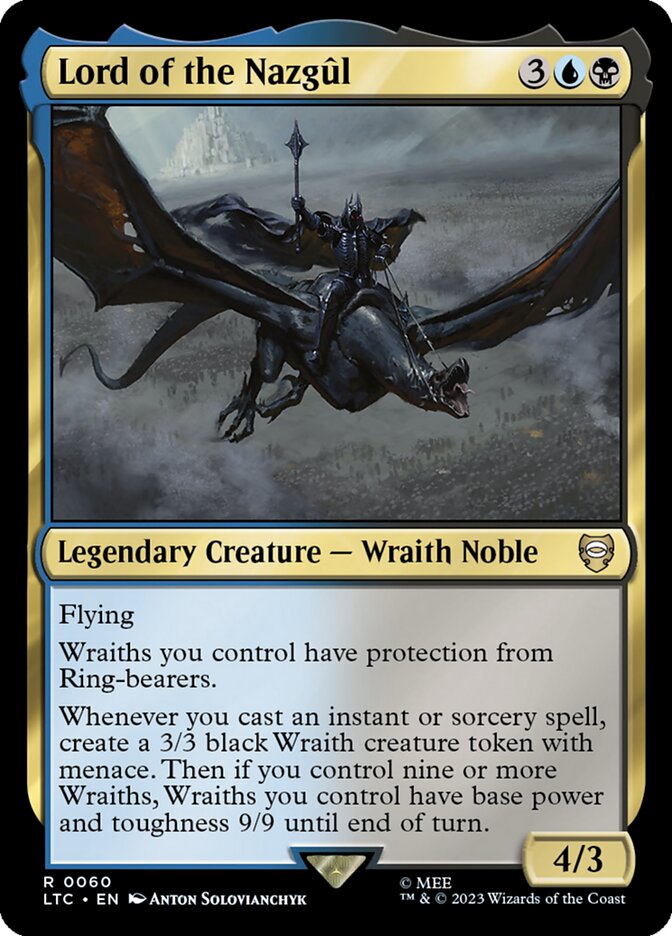
Lord of the Nazgul
FromTheShire: Lord of the Nazgul comes from one of the companion preconstructed Commander decks released alongside the main draft set, and is another card with tribal implications. In this case, the existing tribe is both almost nonexistent and also very bad – of the 11 Wraith creatures that currently exist, 5 of them are newly printed in this set, and only Street Wraith has seen play in the last 25 years or so, and that only because of its cycling ability. How then are we ever going to control 9 Wraiths?
To begin with, we have a little trick up our…evil plate mail gauntlet? One of the cards printed in the set is Nazgul, which allows us to break the normal rules of deck construction in order to have a very appropriate 9 copies. These types of cards come along fairly rarely but when they do they are wildly popular, and this time there are even 9 different artworks to make each one distinct. Still, it’s very unlikely that we will naturally draw these 9 cards in a timely fashion without any of them being destroyed, so we will have to search them out of our deck and stop our opponents’ spells that would disrupt our plan with our own – all of which so happen to be instants and sorceries. This means that simply by doing the things we already need to be doing in the game we will be generating supplemental Wraith tokens to get us to our magic number.
Finally Dimir (blue and black) are home not only to the best tutors and counterspells for this plan, but also to a wide array of clone effects that will allow us to make copies of our Wraiths and good Changeling support which count as all creature types, including Wraith.
Lupe: Another name (title?) of the Witch-King of Angmar was the Lord of the Nazgûl. Here he’s depicted riding a fell beast (or a hell-hawk or Nazgûl-birds – Tolkien never fully decided on a name for them). They are described as such:
…it was a winged creature: if bird, then greater than all other birds, and it was naked, and neither quill nor feather did it bear, and its vast pinions were as webs of hide between horned fingers; and it stank.
The card certainly matches the description. I also like Wraith as a creature type here – accurate and on point and textually authentic. I also think the “gathering of the Nazgûl” as depicted here is on point, especially with them becoming far more terrifying when assembled as the full host of nine. Not a huge amount to say about this one – it’s a simple card from a lore perspective, solidly representing its subject.
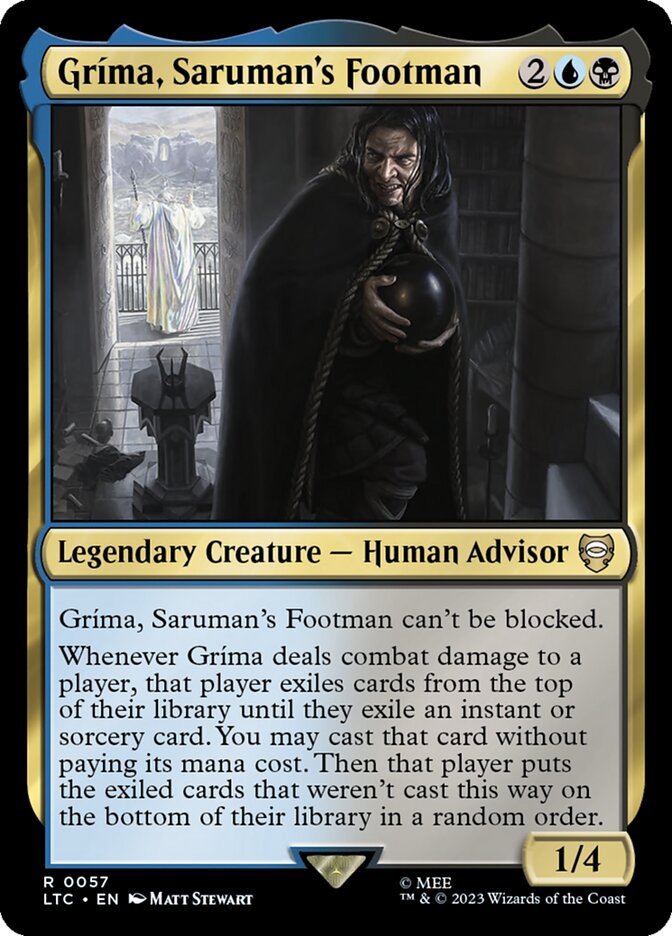
Grima, Saruman’s Footman
FromTheShire: Sensing a theme here? Bad guys are the best, and Grima is the best at worming his way in where he isn’t wanted and stealing everyone else’s stuff. His stats aren’t amazing but they don’t need to be since he’s unblockable, and with enough toughness to survive most of the incidental utility creature killing effects that float around. Instead of focusing on damaging your opponents, he’s rifling through their deck to give you an array of ramp spells for extra lands, targeted removal to deal with problems, card draw spells, utility spells, extra turns, even a board wipe if you’re super far behind and just need a reset button. It’s a little bit incongruous that he’s most well known for stealing a Palantir as shown in the artwork and his ability doesn’t gets you artifacts but I would rather have an instant or sorcery most of the time anyway.
Lupe: “Saruman’s Footman” tells us pretty much exactly the point in the book this card is referring to, as it’s a description Gandalf uses for him. We’re seeing him at the moment just before he hurls a “rock” (actually a palantír) at Gandalf and Saruman. The depiction is off though – you can see Saruman on the balcony behind him, and that’s not where Grima is at this stage – Grima is above him, and hurls the “rock” down at both of them, because at this point he hates both close to equally – as Gandalf says it came from “a window far above”. Despite this discrepancy it captures the scene well, and it’s good to see Grima a little more normal looking, if thin and scrawny (as he should be from Saruman’s mistreatment), than the very theatrical appearance of him in the movies.
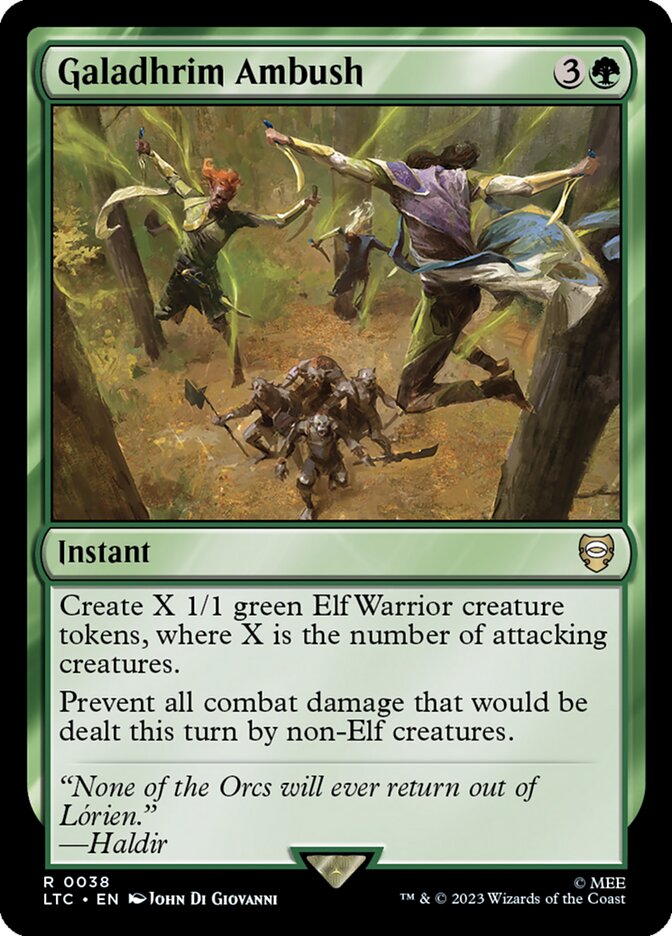
Galadhrim Ambush
FromTheShire: Remember Arachnogenesis from earlier? It’s the OG, and while the tokens it creates are more useful in combat as they are 1/2’s with reach, Elf as a creature type is MASSIVELY more useful than Spider, and Arachnogenesis is already a $45 card because it has only been printed once and is tremendously useful. It’s extremely likely that in a few years this will be the same, especially since the name of the card makes it very difficult to reprint down the road.
The ambush is so good because at instant speed, in combat, you immediately prevent all non-Elf combat damage, meaning right away you’re thwarting an attack that was either going to knock you out of the game or effectively cripple you – already worth the price of admission. On top of that, you then create a bunch of Elf tokens which are able to block however you like and are NOT prevented from doing damage, meaning you can kill a bunch of their best creatures for free. Going even further, if you’re playing this in an Elf deck you will likely have a bunch of other creatures that pump the tokens up to be 2/2’s, 3/3’s, 4/4’s, who knows, AND there are a number of cards like Priest of Titania and Wirewood Channeler that supercharge your mana owing to the influx of tokens.
Lupe: From the quote we can tell exactly when this occurred. Here’s the full context, describing how the Fellowship were followed:
‘A strong company of Orcs has passed. They crossed the Nimrodel — curse their foul feet in its clean water! — and went on down the old road beside the river. They seemed to pick up some scent, and they searched the ground for a while near the place where you halted. The three of us could not challenge a hundred, so we went ahead and spoke with feigned voices, leading them on into the wood.
‘Orophin has now gone in haste back to our dwellings to warn our people. None of the Orcs will ever return out of Lórien. And there will be many Elves hidden on the northern border before another night falls. But you must take the road south as soon as it is fully light.’
This then is the ambush that is launched against those intruding Orcs that wandering in amongst the trees. It’s nice then that this ambush seems to be so well represented as being so efficient, and favouring the Elves so greatly.
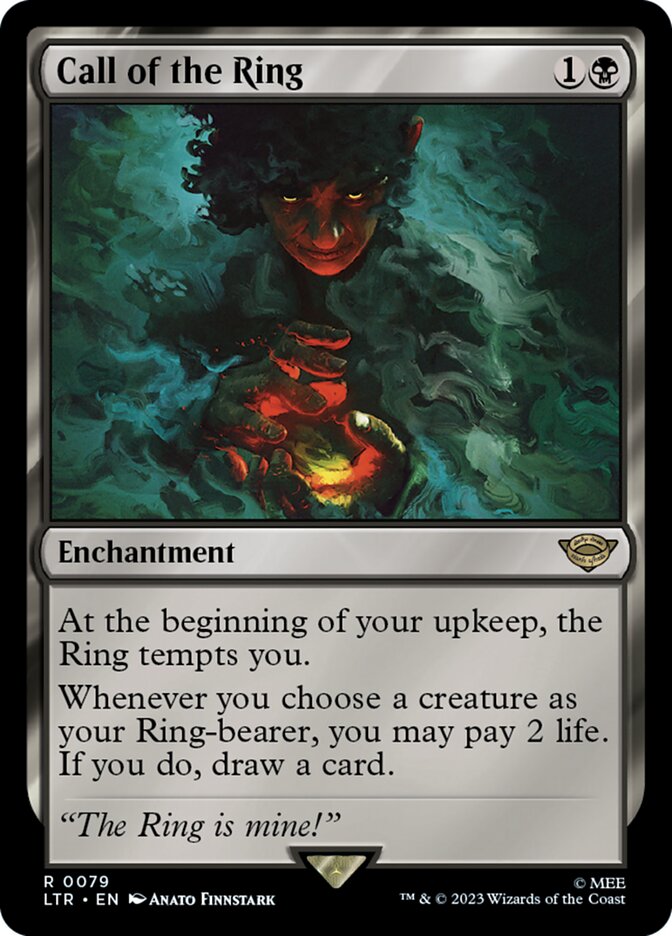
Call of the Ring
FromTheShire: One of the common problems in sets with unique mechanics like this one is that they are generally ‘parasitic’, meaning that they only function within the context of that set and not the wider card pool, and that depending on the mechanic or card in question you may not get the full utility it offers due to lack of support. On the whole, the Ring is probably somewhere in the middle of the scale since even if it only tempts you once you do still get some utility out of it while at the same time you can easily have a deck that doesn’t have enough density of Ring cards to truly function as you want. Since it’s unlikely we will see more tempt cards anytime soon, if ever, Call of the Ring is an extremely important piece to have.
Since it is an enchantment that sticks around on the board to trigger on each of your turns, it provides a vital ‘engine’ to keep tempting happening for all of the other cards in your deck that give you a benefit for being tempted but don’t tempt you themselves. For instance, Sauron’s card draw ability is hugely powerful but if your only way to trigger it is to deal damage with an army, you’re going to struggle. On top of that, it also provides you with a way to trade your life for extra cards, which is a classic, excellent ability in black. All around a fantastic card. Plus damn, that art.
Lupe: The mechanics here are interesting because they don’t parallel the events the card depicts well at all. This is not a moment where a loss occurs (such as it is when Boromir attempts to seize it) but instead it’s a moment of crushing catastrophe, and then exceptional triumph. It comes at the very climax of The Lord of the Rings, when Frodo and Sam have made it into Mount Doom itself.
“I have come,” he said. “But I do not choose now to do what I came to do. I will not do this deed. The Ring is mine!” And suddenly, as he set it on his finger, he vanished from Sam’s sight.”
And yet it is this act, this claiming, that shows Sauron, all at once, that he has failed. That his machinations are for nothing:
And far away, as Frodo put on the Ring and claimed it for his own, even in Sammath Naur the very heart of his realm, the Power in Barad-dûr was shaken, and the Tower trembled from its foundations to its proud and bitter crown. The Dark Lord was suddenly aware of him, and his Eye piercing all shadows looked across the plain to the door that he had made; and the magnitude of his own folly was revealed to him in a blinding flash, and all the devices of his enemies were at last laid bare. Then his wrath blazed in consuming flame, but his fear rose like a vast black smoke to choke him. For he knew his deadly peril and the thread upon which his doom now hung.
From all his policies and webs of fear and treachery, from all his stratagems and wars his mind shook free; and throughout his realm a tremor ran, his slaves quailed, and his armies halted, and his captains suddenly steerless, bereft of will, wavered and despaired. For they were forgotten. The whole mind and purpose of the Power that wielded them was now bent with overwhelming force upon the Mountain. At his summons, wheeling with a rending cry, in a last desperate race there flew, faster than the winds, the Nazgûl, the Ringwraiths, and with a storm of wings they hurtled southwards to Mount Doom.
It would, given this, be nice if it was mechanically represented. Illustration is nice though.
Have any questions or feedback? Drop us a note in the comments below or email us at contact@goonhammer.com.
